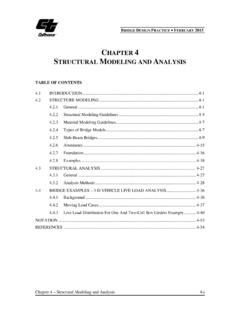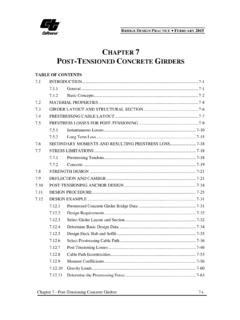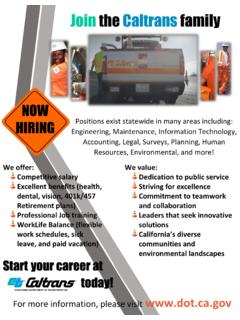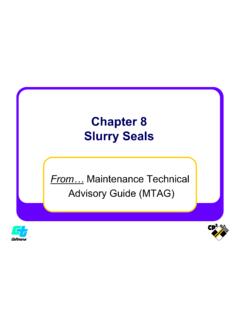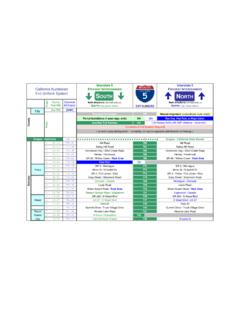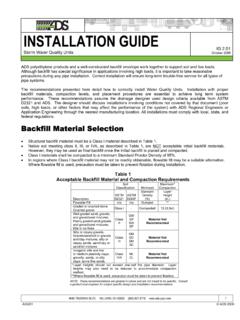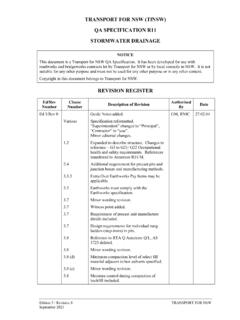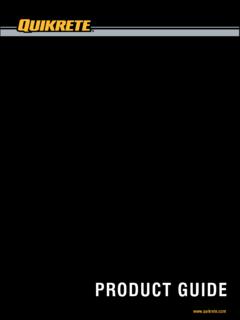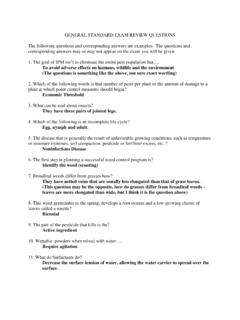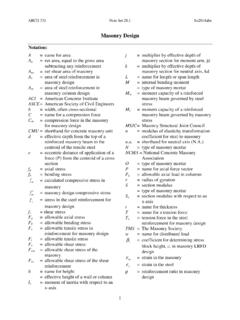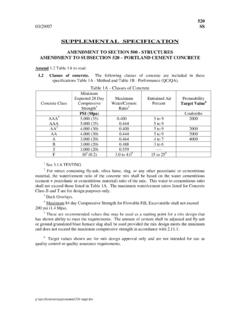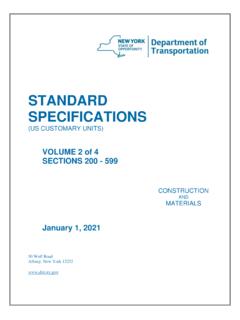Transcription of CHAPTER 8 RAILROAD - California Department of …
1 CHAPTER 8 RAILROAD RAILROADS INTRODUCTION shoring adjacent to railroads present additional challenges in both the review and construction phases. For the purposes of this Manual, the term RAILROAD will refer to the Burlington Northern and Santa Fe Railway (BNSF) and the Union Pacific RAILROAD (UPRR). In the course of the work, SC engineers may encounter other railways such as light rail and commuter trains like Bay Area Rapid Transit (BART). For these other railways, it is acceptable to use the same guidelines presented here unless there are specific instructions from the concerned railway.
2 This CHAPTER is developed using the UPRR General shoring Requirements and the Guidelines for Temporary shoring published by BNSF and UPRR in 2004. The Guidelines were designed as a supplement to the 2002 American Railway Engineering and Maintenance-of-Way Association (AREMA) Manual of Recommended Practice. When reviewing shoring that encroaches on RAILROAD right-of-way, always ensure that the most current editions of both documents are being used. When the RAILROAD requirements conflict with Caltrans or OSHA specifications, always use the more conservative specification.
3 Standard Specifications Section , Preservation of Property, requires excavation plans to be submitted at least 9 weeks prior to beginning of construction. As well as meeting the requirements of the Standard Specifications, contracts with RAILROAD involvement will include a section in the Special Provisions titled RAILROAD Relations and Insurance, typically Section 13. Section 13 will include general requirements for the design and construction of temporary shoring and provide reference to additional information and requirements. The Engineer will be responsible for reviewing the submittal package for compliance and accuracy in the same manner as any other shoring system.
4 Special attention should be paid to the plan and calculation requirements in the Guidelines for Temporary shoring . Submissions of the Plans and Calculations to the RAILROAD are to be routed through the Offices of Structure Construction Headquarters in Sacramento (OSC HQ) in accordance with BCM The OSC HQ will be the Engineer s single point of contact with the RAILROAD through the submittal phase. The RAILROAD may take 6 weeks or more to review the shoring plans and calculations. The contractor may not begin work on any part of the shoring system until Caltrans receives written approval from the RAILROAD .
5 8-1 CT TRENCHING AND shoring MANUAL RR. LL. H Applied Surcharge Load D Figure 8-1. RAILROAD Boussinesq Strip Load Live loads for Railroads are based on the Cooper E80 loading. Cooper E80 is designed to approximate 2 locomotives with 80 kips per axle pulling an infinite train of 8 kips per foot. The lateral pressure from the loading will be determined using the Boussinesq Strip Loading procedure. Since the live loading is considered to be dynamic, use of wall friction in the earth pressure calculations will not be allowed above the dredge line.
6 When using the RAILROAD (RR) live load (LL) curves, the plot of the curve always starts at the elevation of the top of the shoring system as shown in Figure 8-1. SELECTED EXCERPTS FROM Guidelines for Temporary shoring , Published October 25, 2004, BNSF/UPRR (GTS) Scope (GTS section 1, p1) These guidelines are developed to inform public agencies, design engineers, contractors and inspectors of current RAILROAD standards and requirements concerning the design and construction of temporary shoring . The temporary shoring addressed below can be used for all locations where the RAILROAD operates regardless of track ownership.
7 For any items not covered in this CT shoring Manual, please refer to the Guidelines for Temporary shoring as published by BNSF and/or UPRR and the AREMA Manual. Throughout the entire construction, all personnel, RAILROAD tracks, and property need to be protected to ensure the safety and economy of the project. General Criteria (GTS section 2, p1 - 2) The contractor must not begin construction of any component of the shoring system affecting the RAILROAD right-of-way until written RAILROAD approval has been received. 1. All excavations shall be in compliance with applicable OSHA regulations and shall be shored where there is any danger to tracks, structures or personnel regardless of depth.
8 8-2 Revised August 2011 RAILROADS 2. Contractor is responsible for planning and executing all procedures necessary to construct, maintain and remove the temporary shoring system in a safe and controlled manner. 3. Emergency RAILROAD phone numbers are to be obtained from the RAILROAD representative in charge of the project prior to the start of any work and shall be posted at the job site. 4. Contractor must obtain a valid right of entry permit from the RAILROAD and comply with all RAILROAD requirements when working on RAILROAD property.
9 5. The Contractor is required to meet minimum safety standards as defined by the RAILROAD . 6. All temporary shoring systems that support or impact the RAILROAD s tracks or operations shall be designed and constructed to provide safe and adequate rigidity. 7. The RAILROAD requirements, construction submittal review times and review criteria should be discussed at the pre-construction meeting with the Contractor. 8. A flagman is required when any work is performed within 25 feet of track centerline. If the RAILROAD provides flagging or other services, the Contractor shall not be relieved of any responsibilities or liabilities as set forth in any document authorizing the work.
10 No work is allowed within 50 feet of track centerline when a train passes the work site and all personnel must clear the area within 25 feet of track centerline and secure all equipment when trains are present. 9. Appropriate measures for the installation and protection of fiber optic cables shall be addressed in the plans and contract documents. For specific RAILROAD requirements and additional information refer to: or call 1-800-533-2891. , call 1-800-336-9163 or refer to UPRR Fiber Optic Engineering, Construction and Maintenance Standards. 10 Relocation of utilities or communication lines not owned by the RAILROAD shall be coordinated with the utility owners.
